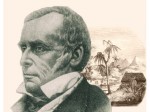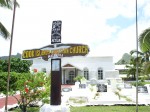
Décrits par Stendhal comme des « Jansénistes du protestantisme », les darbystes sont apparus au milieu du 19ème siècle sous l’influence de John Nelson Darby, ancien prêtre anglican. « Ils considèrent », explique S. Fath dans
Du Ghetto au Réseau, les protestants évangéliques en France, 1800-2005 (Labor et Fides, 2005), « que toutes les églises ont failli, et qu’il convient de supprimer toute forme de clergé et de liturgie, au profit d’une piété ascétique et collégiale ou chacun peut prêcher » (p. 112). En 1845, une scission au sein du mouvement des frères de Plymouth aboutit à la constitution d’un courant darbyste proprement dit, ou « frères étroits » (en anglais «
Exclusive Brethren »), qui se distingue d’un courant moins rigoriste appelé « frères larges » («
Open Brethren »). On imagine aisément une communauté de « frères » dans une des petites vallées du Jura suisse, mais sait-on qu’ils sont aussi présents depuis 1852 en Océanie ?
C’est en effet en 1852 que les premiers « frères » (« larges ») arrivent en Nouvelle-Zélande,
une histoire à laquelle l’historien
Peter Lineham, spécialiste du christianisme néo-zélandais, s’est particulièrement intéressé. C’est donc vers lui que se sont tournés les médias néo-zélandais quand, au cours de la campagne pour les élections législatives de septembre 2005, il est apparu que des « frères étroits » avaient écrit et massivement distribué, en concertation avec le parti conservateur, des tracts anonymes violemment hostiles aux partis vert et travailliste ! Comment comprendre qu’un groupe se proclamant en retrait du « monde » et refusant de voter intervienne de cette manière dans le jeu politique ? L’affaire a donné lieu à plusieurs semaines d’interrogations, de rebondissements et de polémiques (que l’on peut retrouver sur le site internet du
NZ Herald), jusqu’à ce que les sept « frères étroits » impliqués, hommes d’affaires du nord de la Nouvelle-Zélande, acceptent de donner une conférence de presse au cours de laquelle ils ont expliqué leur intervention par leurs convictions « fondamentalistes » (« We are Fundamentalists ») et leur volonté d’épargner au pays un déclin moral irréversible. Ces péripéties et le nombre des « frères » concernés ont bien sûr inspiré aux dessinateurs de presse des caricatures sur le thème de Blanche Neige (rôle tenu par Don Brash, le leader du National Party) et les sept nains. D’autres « frères étroits » ont depuis conduit une campagne similaire sur l’île australienne de Tasmanie.
Au recensement de 2001, la Nouvelle-Zélande (environ 4 millions d’habitants) comptait 1950 « frères étroits », 10149 « frères larges », à quoi s’ajoutent des « frères » recensés comme « frères de Plymouth » (435, peut-être les FP4 évoqués par S. Fath dans
une note de mai dernier ?) ou simplement comme « Brethren » sans autre précision (7503). Les « frères larges » néo-zélandais ont mené des missions parmi les Maori et ont en outre contribué à la diffusion du mouvement dans les îles polynésiennes. Les études de cas publiées dans le livre récent
Globalization and the Re-Shaping of Christianity in Oceania (voir note antérieure) permettent d’en retrouver la trace :
-
à Samoa.
La Apia Christian Fellowship est née en 1954 de la rencontre entre un missionnaire précédemment implanté chez les Maori (alors en escale à Fidji entre les îles Cook et la Nouvelle-Zélande), un missionnaire samoan de la London Missionary Society’s Samoan Congregation à Fidji et un couple d’enseignants samoans méthodistes. Elle compte environ 500 membres, qui se réunissent au Gospel Hall de la capitale samoane.
- à Tuvalu.
Les frères y sont présents depuis 2001, à l’initiative de deux Tuvaluans convertis à Fidji, avec une communauté embryonnaire d’une quarantaine de personnes.
Ce qui suggère, même si le chapitre consacré à Fidji ne le dit pas, que des groupes de « frères larges » existent également à Fidji.
(illustration : John N. Darby en Polynésie, collage Y. Fer)
 A few months ago, I made my article on Hakka Protestants in French Polynesia, published in 2004 in Perspectives Chinoises, accessible on the web in its French version. This article was also published in English (China Perspectives n°57, 2005).
A few months ago, I made my article on Hakka Protestants in French Polynesia, published in 2004 in Perspectives Chinoises, accessible on the web in its French version. This article was also published in English (China Perspectives n°57, 2005). The islands of Polynesia are located in a triangle whose three corners are New Zealand (South), Rapa Nui also called Easter Island (East) and Hawaii (North). French Polynesia is roughly at the centre of this triangle and is made of five archipelagos: The Windward Islands (Tahiti and Moorea), the Leeward Islands (the most famous being Bora Bora), the Austral Islands, the Tuamotu-Gambier and the Marquesas.
The islands of Polynesia are located in a triangle whose three corners are New Zealand (South), Rapa Nui also called Easter Island (East) and Hawaii (North). French Polynesia is roughly at the centre of this triangle and is made of five archipelagos: The Windward Islands (Tahiti and Moorea), the Leeward Islands (the most famous being Bora Bora), the Austral Islands, the Tuamotu-Gambier and the Marquesas. Décrits par Stendhal comme des « Jansénistes du protestantisme », les darbystes sont apparus au milieu du 19ème siècle sous l’influence de John Nelson Darby, ancien prêtre anglican. « Ils considèrent », explique S. Fath dans Du Ghetto au Réseau, les protestants évangéliques en France, 1800-2005 (Labor et Fides, 2005), « que toutes les églises ont failli, et qu’il convient de supprimer toute forme de clergé et de liturgie, au profit d’une piété ascétique et collégiale ou chacun peut prêcher » (p. 112). En 1845, une scission au sein du mouvement des frères de Plymouth aboutit à la constitution d’un courant darbyste proprement dit, ou « frères étroits » (en anglais « Exclusive Brethren »), qui se distingue d’un courant moins rigoriste appelé « frères larges » (« Open Brethren »). On imagine aisément une communauté de « frères » dans une des petites vallées du Jura suisse, mais sait-on qu’ils sont aussi présents depuis 1852 en Océanie ?
Décrits par Stendhal comme des « Jansénistes du protestantisme », les darbystes sont apparus au milieu du 19ème siècle sous l’influence de John Nelson Darby, ancien prêtre anglican. « Ils considèrent », explique S. Fath dans Du Ghetto au Réseau, les protestants évangéliques en France, 1800-2005 (Labor et Fides, 2005), « que toutes les églises ont failli, et qu’il convient de supprimer toute forme de clergé et de liturgie, au profit d’une piété ascétique et collégiale ou chacun peut prêcher » (p. 112). En 1845, une scission au sein du mouvement des frères de Plymouth aboutit à la constitution d’un courant darbyste proprement dit, ou « frères étroits » (en anglais « Exclusive Brethren »), qui se distingue d’un courant moins rigoriste appelé « frères larges » (« Open Brethren »). On imagine aisément une communauté de « frères » dans une des petites vallées du Jura suisse, mais sait-on qu’ils sont aussi présents depuis 1852 en Océanie ?